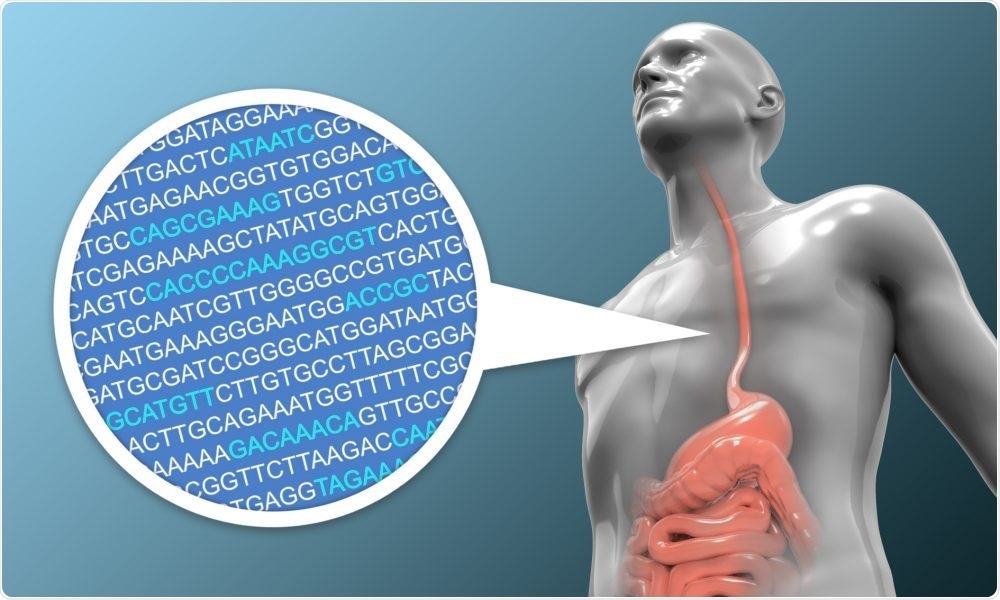Globally, esophageal cancer is said to be the eighth most common cancer and it usually develops from a condition known as Barrett’s esophagus.

Genomic data could help predict a patient’s risk of developing esophageal cancer. Image Credit: Spencer Phillips/EMBL-EBI.
Current treatment and monitoring approaches are highly intrusive and several patients have to go through difficult procedures to make sure that no cancer is overlooked.
Now, scientists have designed a statistical model that employs genomic information to precisely estimate whether a patient suffering from Barrett’s esophagus has a low or high risk of developing cancer.
Genomics and statistics come together
A research team from the University of Cambridge, EMBL’s European Bioinformatics Institute (EMBL-EBI), and colleagues sequenced genomes from biopsies that are regularly obtained from patients suffering from Barrett’s esophagus.
The researchers monitored these patients for early signs of esophageal cancer. They used the information to observe the differences between patients who were eventually diagnosed with esophageal cancer and those who were not. They later used this information to design a statistical model that quantifies the individual risk of every patient. The study was published in the Nature Medicine journal.
Other new cancer studies have also demonstrated that genomic mutations that cause cancer may occur several years before a patient is diagnosed with the disorder. The potential to detect these mutations could offer a novel method for early diagnosis and treatment of esophageal cancer.
With the help of genomic information obtained from 88 patients suffering from Barrett’s esophagus, the team identified 50% of the patients, who were diagnosed with esophageal cancer, as “high risk” over eight years prior to diagnosis. The numbers increased to 70% two years prior to diagnosis. Equally significant, the statistical model also precisely estimated patients who have a very low risk of developing esophageal cancer.
One of the unique things about this study was the richness of the data provided by colleagues at Addenbrooke’s Hospital in Cambridge. These patients have been in surveillance for over 15 years, so overall we had over 800 samples, taken over time and from different areas of the oesophagus.”
Moritz Gerstung, Group Leader, European Molecular Biology Laboratory - European Bioinformatics Institute
Gerstung continued, “This allowed us to measure in great detail what type of genomic changes occur and how these trajectories differ between patients with and without cancer. Without such thorough surveillance programmes, this study wouldn’t have been possible.”
The benefit of early detection
While individuals with Barrett’s esophagus have a significantly higher risk of developing esophageal cancer when compared to the general population, just 1 out of 300 patients will be diagnosed with cancer every year.
Nonetheless, these patients have to undergo intrusive monitoring procedures once in two years. This surveillance can be stressful, uneasy, and time-intensive for the patients, and it also places an extra burden on the healthcare system.
The benefit of our method is twofold. The patients who have high-risk Barrett’s, which is likely to become cancerous, can receive treatment earlier. And individuals who have something that looks genetically stable, and unlikely to develop into the disease, do not need to undergo such intense surveillance. The hope is that our method can help improve early detection and treatment, and decrease unnecessary treatment for low-risk patients, without compromising patient safety.”
Sarah Killcoyne, Visiting Postdoctoral Fellow, European Molecular Biology Laboratory - European Bioinformatics Institute
These outcomes indicate that patients who have the greatest risk of developing esophageal cancer can be treated instantly, instead of performing recurrent biopsies until the detection of early signs of cancer.
On the other hand, patients who have low risk and stable disease can be tracked less often. On the whole, the authors estimate that surveillance can be decreased for half of the patients with Barrett’s esophagus.
This is an exciting example of how a collaboration between computational biologists and clinician scientists can bring new insights into an important clinical problem. Oesophageal cancer is devastating when it is diagnosed late, but early intervention can be performed endoscopically and spare patients unnecessary chemotherapy and removal of their oesophagus. Similar approaches could be extended to other cancer types in the future.”
Rebecca Fitzgerald, Professor of Cancer Prevention, University of Cambridge
Fitzgerald is also an MRC Programme Leader at the University of Cambridge.
According to the study’s authors, the subsequent steps are to improve the approach, ideally by examining the information from additional patients. It is equally significant to bring in clinical data and enhance the accuracy of the statistical model. This will ultimately lead to clinical trials to demonstrate that this statistical model is handy in clinical practice for patients who are currently being monitored.
Source:
Journal reference:
Killcoyne, S., et al. (2020) Genomic copy number predicts esophageal cancer years before transformation. Nature Medicine. doi.org/10.1038/s41591-020-1033-y.